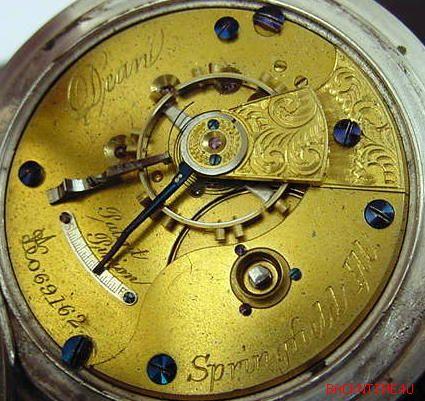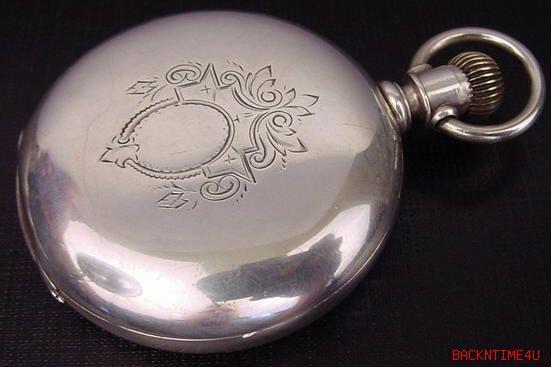
| WWT Shows | CLICK TO: Join and Support Internet Horology Club 185™ | IHC185™ Forums |

|
• Check Out Our... • • TWO Book Offer! • |
Welcome Aboard IHC185™  Internet Horology Club 185
Internet Horology Club 185  IHC185™ Discussion Site Main Page
IHC185™ Discussion Site Main Page  Horological Discussions, Questions and Answers
Horological Discussions, Questions and Answers  Pocket Watch Discussions
Pocket Watch Discussions  Two Star Bargain???
Two Star Bargain???
 Internet Horology Club 185
Internet Horology Club 185  IHC185™ Discussion Site Main Page
IHC185™ Discussion Site Main Page  Horological Discussions, Questions and Answers
Horological Discussions, Questions and Answers  Pocket Watch Discussions
Pocket Watch Discussions  Two Star Bargain???
Two Star Bargain???Go  | New Topic  | Find-Or-Search  | Notify  | Tools  | Reply to Post  |  |
Just when you start believing that it takes $3,000 or more to acquire a “rare” watch, something like this comes along. This is an Illinois Dean, hunter-case watch purchased on eBay, that arrived today. Snyder’s database says that it was produced in 1878 as part of a single run of 300 movements. It is key-wind. I think it is also stem-wind as a “transitional” movement. I asked the seller to try and wind it and he said that he did put about 3 turns of wind on it before it stopped responding. The case is not a key-wind case and the lack of case screw marks suggests that it may be original AND stem-wound. It will not stem-wind right now and I'd have to uncase it to see if it really is transitional, at this point. Shugart has it at two-stars, although….. based upon his system, a watch of under 350 production, should be three-stars. I only paid $320.00 for it and I was surprised that I got it. The book value is not high but …. gee…. 300 production? I haven’t had time to photograph it (photos are the sellers, off eBay) or to service it. It obviously needs cleaning and some attention (perhaps) to the wind mechanism.  | |||
|
Dial has just one tiny hairline although it is nothing special. In fact, the "Dean" was not a particularly fancy watch, unadjusted and without frills.  | ||||
|
The case, in my opinion, is great.... especially for the price. It is what first attracted me to the watch. It is worn but not badly. It still has very clear, simple engraving. The covers all snap shut, opening mechanism is working fine and the covers open to 90 degrees. It is coin-silver and feels like at least 4oz. If the movement IS transitional, this case might arguably be original to the watch. Even as just an empty case, I would think that it is easily worth more than $100.00 alone.  | ||||
|
Peter, I am not an expert, a couple of things on this watch. It is most likely a Mdl 2 as it has 2 case screws and Mdl 1's had 1..2nd, it appears to have the up and down lever set.. Hard to find on any key wind from the factory..Case looks cut for this..Check to see if the bezel is hinged.. I think it is probably stem wind also..the winding problem may have to do with the crown riding alittle high..Have never seen just key wind and stem set, except on a couple of early American Watch Co Mdl 1857's..the last thing, not many pay big money for American keywinds, don't know why, if they did I could retire..Nice find in my opinion !!!!! | ||||
|
Thanks John.... Snyder's database puts it as a model 2. I guess you're saying that all model 2's were transitional? Like I said, I didn't uncase it but I'm 99% sure that it is stem wound. And... like I said, I don't intend to retire on it but it's very nice to own something so scarce. As you can see, it was not a fancy watch and those 300 must have seen some pretty heavy service. I wonder how many survived? | ||||
|
I "restored" this watch last week. My intention was to service the movement and to do minimal cleaning to the case and dial. The case was lightly buffed to make it look cleaner but still old. That came out nice. The dial looks free of hairlines and it was simply soaked a bit to clean it. The movement was cleaned in the ordinary way. In reassembling it, I made a stupid, stupid mistake and badly bent the pallet pivot. A few phone calls told me that I would NOT easily find a replacement. So... Galen Gudenkauf MADE an entire new pallet-pinion out of steel stock. When I returned to the shop, the train was assembled and running free. I then finished assembly and was shocked to find that we were able to time it, in four positions, to +2 beats (in two) and -1 beat (in two). That's RR Standards in an old watch that was manufactured as unadjusted. And... it is running with an entirely new pallet-pinion. I'm in awe of those kinds of watchmaking skills. I was also superpleased at how the movment cleaned. The plates, free of dirt, now look almost brand new. With a total production of only 300, hard use and almost 130 yrs, I can't imagine that there are many survivors in this condition.  | ||||
|
| IHC Member 163 |
Dog gone, that's a pretty thing, Peter! Makes me want to go home and dig out my Elgin 228 and wear it! HIGH regards! Mark | |||
|
| IHC President Life Member |
Beautiful workmanship and a great story too! Thanks for sharing both with all of us. | |||
|
Peter: I'm struck by your story and "before" and "after" pictures. Outstanding! I would also like to ask about your plate cleaning process... Could you help a newby with "in the ordinary way"? | ||||
|
I have lots of secrets for dials and cases but I do very little on plates. There are a few ways to "goose-up" a nickle case but there are very few that I would attempt with a gilded plate. So... it was simply cleaned. At the shop, where I am a student, we use an L&R machine that employs agitation and ultrasound. There are 5 baths... 3, non-ammoniated cleaners and two duo-lube for rinse and preservation. We oil the winding mechanism and jewels by hand. Gilded plates stain easily and tend to flake. I would be afriad to use anything stronger on them or anything that had ammonia. Ammonia will produce some fantastic results in the short term but can dull or damage plates over time. The quality of this cleaning job was just dumb luck. The condition of the plates was superb... they were just dirty. Had they been stained, there would be very little that I would attempt to change it. | ||||
|
I should add that..... Inside the movement, I found that a winding spring was broken. This spring pushes the winding mechanism back into "wind" position after the lever has moved it to "set." The other end of the spring powers the click. I also found that the rachet-gear had a broken tooth and that the primary winding wheel had slightly rough teeth (wonder why?). I was able to replace the spring with one from a parts-watch of similar age. I was unable to find a rachet gear with precisely the same configuration, so I kept the one I had, broken tooth and all. Likewise the winding gear which I doused with a liberal amount of watch-grease and my best wishes! The result is that the watch has been restored to full-transitional winding, albeit just a tad rough. Old watches do force compromises. | ||||
|
Peter Very nice watch and a very nice restoration job. I always read your shop exploits with great interest. I envy your watchmaker relationship and wonder at the skill you are developing. Keep it up and keep those posts coming! Ron | ||||
|
I didn't feel very "skillful" when I bent that pallet pivot and had to bring it "up-front" with my tail between my legs! | ||||
|
| Powered by Social Strata |
| Your request is being processed... |
|
©2002-2025 Internet Horology Club 185™ - Lindell V. Riddle President - All Rights Reserved Worldwide

